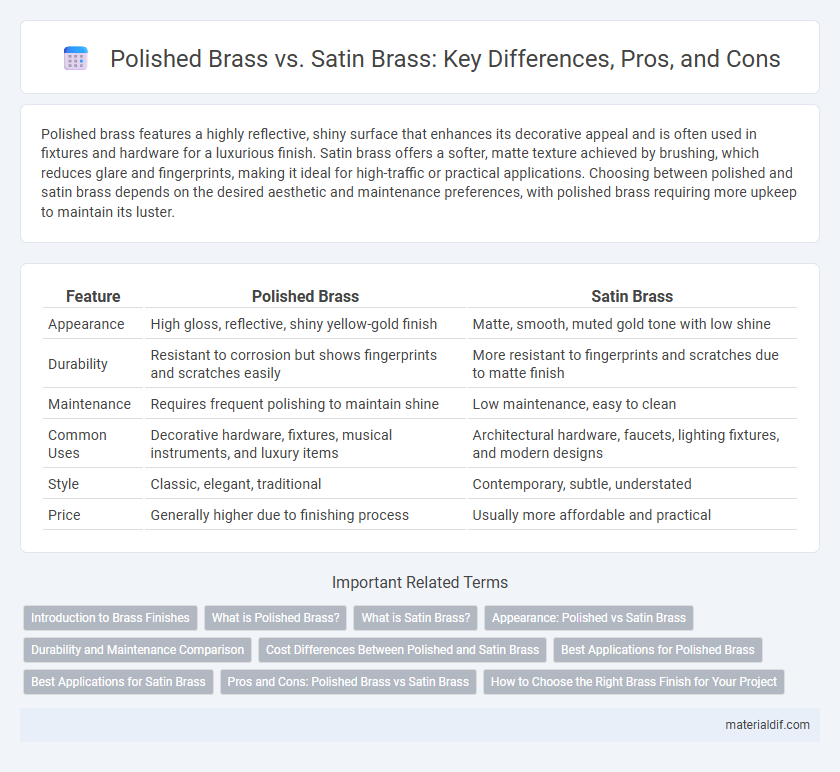Polished brass features a highly reflective, shiny surface that enhances its decorative appeal and is often used in fixtures and hardware for a luxurious finish. Satin brass offers a softer, matte texture achieved by brushing, which reduces glare and fingerprints, making it ideal for high-traffic or practical applications. Choosing between polished and satin brass depends on the desired aesthetic and maintenance preferences, with polished brass requiring more upkeep to maintain its luster.
Table of Comparison
| Feature | Polished Brass | Satin Brass |
|---|---|---|
| Appearance | High gloss, reflective, shiny yellow-gold finish | Matte, smooth, muted gold tone with low shine |
| Durability | Resistant to corrosion but shows fingerprints and scratches easily | More resistant to fingerprints and scratches due to matte finish |
| Maintenance | Requires frequent polishing to maintain shine | Low maintenance, easy to clean |
| Common Uses | Decorative hardware, fixtures, musical instruments, and luxury items | Architectural hardware, faucets, lighting fixtures, and modern designs |
| Style | Classic, elegant, traditional | Contemporary, subtle, understated |
| Price | Generally higher due to finishing process | Usually more affordable and practical |
Introduction to Brass Finishes
Polished brass features a highly reflective, shiny surface that enhances the bright yellow-gold appearance, commonly used in decorative fixtures and hardware for a classic, elegant look. Satin brass offers a muted, matte finish with a soft luster, providing a more contemporary and subtle aesthetic that resists fingerprints and tarnishing. Both finishes derive from brass alloy compositions, primarily copper and zinc, with surface treatment processes that determine their distinct visual and tactile qualities.
What is Polished Brass?
Polished brass is a type of brass finish achieved by buffing the metal to a high shine, creating a smooth, reflective surface that enhances its golden-yellow appearance. This finish emphasizes the natural luster of brass, making it popular for decorative hardware, fixtures, and musical instruments. Polished brass requires regular maintenance to prevent tarnishing and maintain its bright, glossy look.
What is Satin Brass?
Satin brass is a type of brass finish characterized by its smooth, matte appearance created through fine brushing or sanding techniques. The finish reduces reflective shine while maintaining the warm, golden tones typical of brass, making it popular for interior hardware and decorative accents. Durable and resistant to fingerprints, satin brass offers a subtle elegance compared to the highly reflective polished brass finish.
Appearance: Polished vs Satin Brass
Polished brass features a glossy, mirror-like finish that enhances its bright golden color, creating a reflective and elegant appearance ideal for decorative accents. Satin brass, in contrast, exhibits a muted, matte surface with a soft sheen, giving it a more understated and modern look that resists fingerprints and smudges. The choice between polished and satin brass hinges on desired aesthetic impact and maintenance preferences.
Durability and Maintenance Comparison
Polished brass features a glossy, reflective finish that highlights its natural golden hue but requires regular cleaning and polishing to prevent tarnish and maintain its shine. Satin brass offers a matte, brushed texture that effectively conceals fingerprints and minor scratches, resulting in lower maintenance and longer-lasting appearance in high-traffic or humid environments. Both finishes demonstrate strong durability due to brass's inherent corrosion resistance, but satin brass is preferred for practicality and ease of upkeep in demanding conditions.
Cost Differences Between Polished and Satin Brass
Polished brass typically costs more than satin brass due to the additional labor and time required for its high-gloss finishing process, which enhances its reflective surface. Satin brass, with its matte, brushed appearance, involves less intensive polishing, resulting in lower manufacturing costs and more affordable pricing. The cost difference can vary by supplier but generally ranges from 10% to 25%, making satin brass a budget-friendly option for decorative hardware and fixtures.
Best Applications for Polished Brass
Polished brass, with its bright, reflective finish, is best suited for decorative applications such as hardware, fixtures, and musical instruments where visual impact and elegance are essential. Its smooth and shiny surface resists tarnishing when properly maintained, making it ideal for high-visibility areas in interior design and luxury products. Polished brass excels in environments requiring both aesthetic appeal and durability, including doorknobs, lighting fixtures, and furniture accents.
Best Applications for Satin Brass
Satin brass offers a muted, matte finish that reduces glare and fingerprints, making it ideal for high-traffic areas such as door hardware, bathroom fixtures, and kitchen accessories. Its subtle texture provides a modern, sophisticated look that complements contemporary and industrial interior designs. Satin brass's durability and resistance to tarnish also make it suitable for frequently handled items, ensuring long-lasting aesthetic appeal.
Pros and Cons: Polished Brass vs Satin Brass
Polished brass offers a high-gloss, reflective finish that enhances brightness and elegance but requires frequent maintenance to prevent tarnishing and fingerprints. Satin brass features a muted, matte surface that resists fingerprints and wear, providing a more contemporary and low-maintenance option while sacrificing some of the shine and traditional appeal of polished brass. Choosing between polished and satin brass depends on balancing aesthetic preference with durability and upkeep needs.
How to Choose the Right Brass Finish for Your Project
Polished brass offers a shiny, reflective surface that enhances traditional and decorative designs, making it ideal for projects requiring a luxurious appearance and easy cleaning. Satin brass provides a muted, matte finish that resists fingerprints and tarnishing, suitable for modern, understated aesthetics and high-traffic areas. Selecting the right brass finish depends on the desired visual impact, maintenance level, and the environment where the brass will be used.
Polished Brass vs Satin Brass Infographic

 materialdif.com
materialdif.com